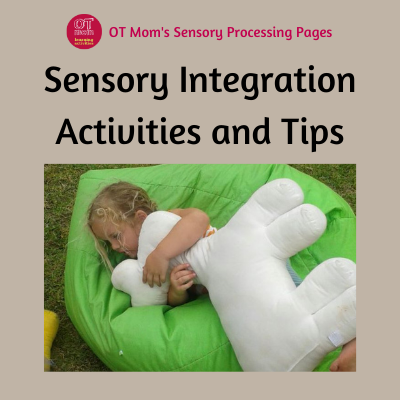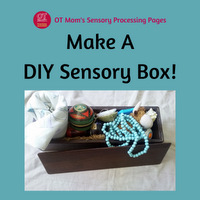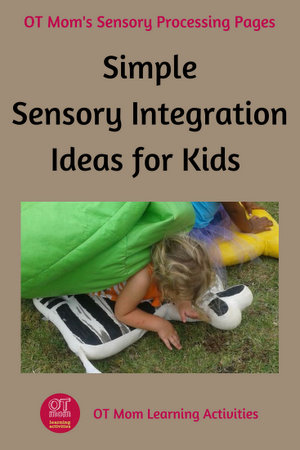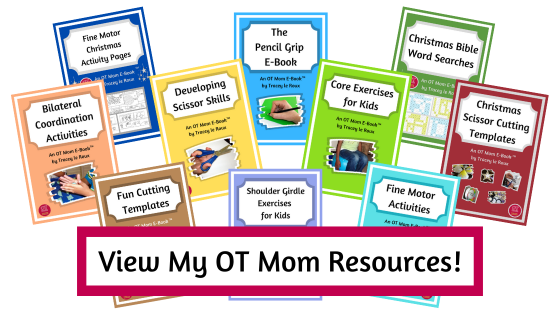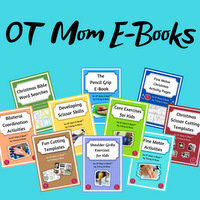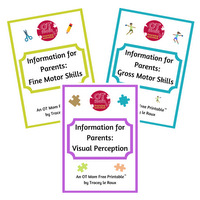- Home Page
- Sensory Integration Activities
Sensory Integration Activities
Sensory integration activities can prompt the brain to process sensory information more effectively, helping the child respond more appropriately to the environment.
The simple sensory integration activities on this page are aimed primarily at children experience difficulties with sensory modulation. These children may be
- sensory seeking,
- under responsive to sensory stimulation, or
- over responsive to sensory stimulation. Over responsive children are sometimes described as tactile defensive or sensory defensive.
If these terms are new to you, pop over and read my information page on sensory processing to get a better understanding.
Parents can make use of these simple sensory integration activities and exercises to complement occupational therapy sessions that their child may be receiving. If your child is receiving occupational therapy, please ensure you check the suitability of the activities with your child's therapist! The information on this page is not a substitute for an occupational therapy evaluation!
This page contains affiliate links (#Ad) to products similar to what I use. I may receive a commission if you purchase through my links. However, you are under no obligation to purchase anything.
I sometimes link to products (#Ad) that are similar to those I use and love. If you do purchase something through my links, I will receive a small commission that helps support my site - thank you!
Creating a Safe Sensory Corner
Having a safe space that can help a child deal with sensory processing issues is an important step in assisting the child to recognize strategies that work for his/her specific needs.
The beauty of a “sensory corner” is that it can provide stimulation to the under-responsive child, sensory input for the sensory seeking child, and a safe retreat for the sensory defensive child.
There is no set recipe or instructions for making a sensory corner - you will need to discover what your child responds well to by observing your child, talking with your child, and getting feedback from therapists and teachers who are involved with your child.
You can make your sensory corner fit your budget and your resources, as well as the space you have available!
Here are a few suggestions:
Make a "Sensory Corner" by blocking off a corner of a room and using soft furnishings with a variety of textures.
-
Provide lots of blankets and cushions that your child can snuggle into.
Weighted blankets and lap pads are also useful.
- An old mattress can also double as a crash pad if your child finds it helpful to crash onto something soft.
- We personally found that big comfy bean bag chairs#Ad provide wonderful deep pressure and a snuggly effect which can be very calming.
 Beanbag chair
Beanbag chair- Some children enjoy being completely secluded in a little tent or wigwam#Ad like the one shown.
Others, however, prefer to not be closed off, so find out what works for your child!
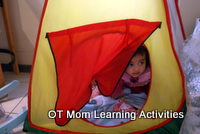 In a tent
In a tent- Some children find a lava lamp#Ad or fish aquarium soothing to look at.
- Others appreciate having headphones with which they can listen to soft soothing music, or even to white noise.
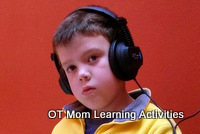 Wearing headphones
Wearing headphonesPut A Sensory Box In The Sensory Corner
A "sensory box" is filled with objects that have different textures and weights, that your child can explore or fiddle with.
- Playing with or touching these objects could be soothing for an overstimulated child, or calming for a child who is wound up and sensory seeking.
- Fiddling with quiet items in the box can also be used to help a distractible child focus on listening to a book being read or help them pay attention to a lesson.
Find out more about how to make your own sensory box with objects you probably already have at home!
Heavy Work / Proprioceptive Activities
Information from the muscles and joints is called proprioception.
Proprioceptive information comes to the brain from muscles and joints which are moving, especially when they are working hard. That is why they are often referred to as heavy work activities.
Heavy work activities help your child to really “feel” their muscles and joints working, and the proprioceptive information sent to the brain helps your child's brain to integrate sensory information more effectively.
If your child struggles to sit still to listen to a lesson, then try a stress ball to squeeze, chewing gum, or a special chew toy to give proprioception input before or during the lesson.
In addition, try incorporating some of the following heavy work suggestions into your child's daily routine - these are excellent sensory integration activities for kids who are always craving movement and crashing into things. They can also help stimulate a lethargic child.
- Let your child push a trolley, sweep the yard, dig in the garden, or any other activity that lets their muscles work hard.
- Jumping on a trampoline and climbing on playground equipment are also good for proprioceptive input.
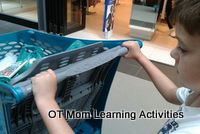 Pushing a trolley
Pushing a trolley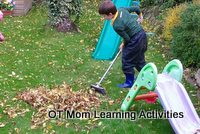 Raking leaves
Raking leaves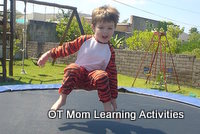 Bouncing
Bouncing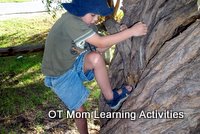 Climbing
ClimbingDeep Pressure Activities
Giving deep pressure is a very effective way of helping an overstimulated or distressed child to calm down and reorganize his/her emotions and behavior.
Have you ever felt much better after getting a bear hug from someone you love? Deep pressure works the same way! Although it seems passive, these deep pressure ideas are great sensory integration activities.
Here are some simple ways to provide deep pressure for your child:
- Let your child lie on a mat or folded blanket and pack pillows on top of your child t(Tip - make this a game where you make your child into a pizza or a sandwich!) Very Important: Never cover your child's face!!
- Your child may also enjoy being wrapped in a blanket or snuggling under a giant beanbag#Ad for some deep pressure stimulation.
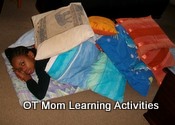 Covered with pillows and cushions
Covered with pillows and cushions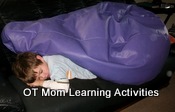 Snug under a giant bean bag
Snug under a giant bean bag- The child in the photo is sitting in a snug kiddie armchair#Ad and using a hand-held muscle massager#Ad.
The snugness of the chair helps him feel secure and the muscle massager gives him vibrating deep pressure input on his arms and legs, which he finds soothing.
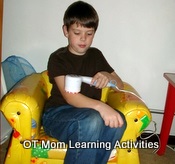 Using a handheld massager
Using a handheld massager- Weighted vests#Ad, weighted blankets and weighted lap blankets#Ad are also effective ways to give passive proprioceptive input, and many children find the deep pressure sensory support to be very helpful and calming
Vestibular Sensory Integration Activities
Most movement activities will stimulate the vestibular system in the inner ear, which helps the body to know how it is moving and how fast it is moving.
Depending on their intensity, vestibular activities can be stimulating for an under-responsive child, or calming for a sensory seeking or over-responsive child.
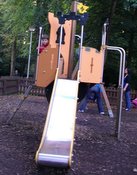 Use the slide!
Use the slide!Trampolines, rocking horses, swings, roundabouts or slides are all good vestibular sensory integration activities. I have a page that includes a few simple vestibular exercises you can try in the classroom, as well!
A child who is gravitationally insecure may fear movement and avoid escalators, elevators and playground apparatus. They need to experience very gentle, safe movement.
It will be less scary for them to move while sitting or lying down, rather than while standing up, or to try a gentle activity while being held by a parent.
Try gentle bouncing on a trampoline while lying or sitting, swinging on a
very low swing, and rocking on a rocking horse.
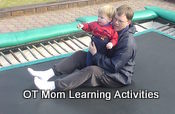 Bouncing on a trampoline
Bouncing on a trampolineBe careful not to force a fearful child to take part in an activity – be guided by your child's reactions.
Oral-Motor Activities
Some children chew excessively on clothing, pencils and other inappropriate objects. They are usually seeking tactile and proprioceptive input through their mouths, perhaps to help themselves concentrate or to reduce anxiety.
if you have ever munched your way through a bag of chewy candy or popcorn when feeling stressed, then you know what I am talking about!
- Some kids (and adults!) benefit from chewing gum or eating very crunchy food at meal/snack times. But eating isn't always the best option for every situation, so if your child needs to chew on something in order to calm down or focus, try a "chewy" like these special chewy pendants#Ad.
- Blowing bubbles with a straw, sucking thick
milkshake/yogurt through a straw and blowing on harmonicas are also simple
sensory integration activities that can help meet a child's oral-motor
needs.
Try including a paper straw with your child's lunch!
 Using a straw
Using a strawHelpful Books and Resources
- No Longer A Secret #Ad is a book full of practical, easy-to-implement, sensory integration activities and tips that be can used at home and at school.
- Max and Me #Ad is a fantastic book for kids, to help them understand how and why they may be struggling with sensory integration.
- Check out my brief reviews of a wide range of sensory processing books - suitable for parents, teachers and therapists!
These related pages on my site may also be helpful for you:
- An overview of sensory processing and SPD
- How sensory processing differences can affect kids at school
- How sensory processing differences can affect babies and toddlers
- Make your own sensory box!
Thank you for visiting my page! I hope you found these sensory integration activities to be useful!
Please do share with anyone you think may benefit.
If you want to to stay in touch with new pages and updates to my site, please sign up for my occasional newsletter!
- Home Page
- Sensory Integration Activities
Share this page to help others!
References
- Miller, L.J. (2006). Sensational Kids. New York: Perigree. (revised edition 2014 by TarcherPerigree)
- Bialer, D.S.; Miller, L.J. (2011) No Longer A Secret. Texas: Sensory World Publishing
- Biel, L. ; Peske, N. (2009) Raising A Sensory Smart Child. New York: Penguin Books
- Kranowitz, C.S. (2003) The Out-Of-Sync Child Has Fun. New York: Perigree
You can view brief reviews of each book on my OT Books page.
Didn't find what you were looking for? Try a search of my site!
